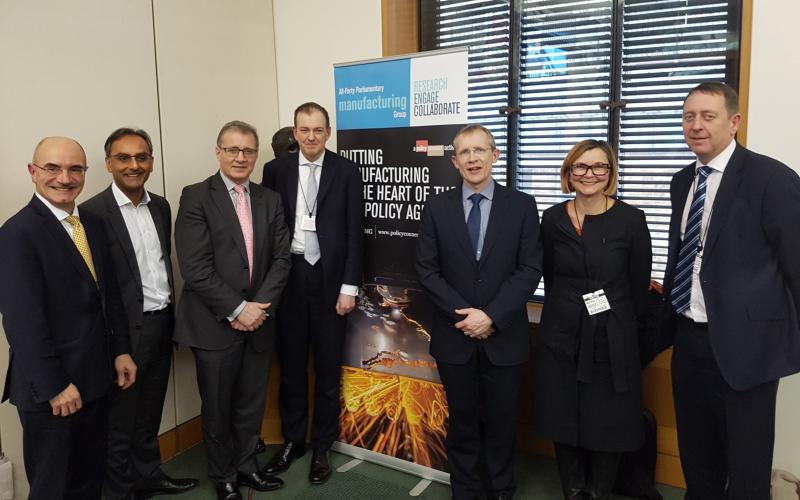R&D in the Industrial Strategy

In a brilliant panel discussion chaired by Mark Pawsey MP, our members discussed the important topic of how R&D can be supported by the government’s Industrial Strategy. Our panel included BAE Systems, Boeing, the High-Value Manufacturing Catapult, National Physical Laboratory, Cambridge’s Institute for Manufacturing and Autodesk. The discussion focused on how innovation is supported, both by the state and in industry, and how this activity can be incentivised across the manufacturing sector.
Chair: Mark Pawsey MP, vice-chair of the APMG
Panel:
- Dick Elsy, High-Value Manufacturing Catapult
- Paula Knee, National Physical Laboratory
- Prof Tim Minshall, Institute for Manufacturing, Cambridge University
- Asif Moghal, Autodesk
- Steve Timms, BAE Systems
- Richard Mills, Boeing
Commitment to increased central R&D spending is welcome
Both the panel and the audience widely welcomed the government’s commitment in the Industrial Strategy White Paper to increase central government funding of science, technology, research and development to 2.4% of GDP, the OECD average, over the next ten years. However, some in the room expressed concern that this target was potentially not ambition enough, especially in a global race where the UK’s key competitors (Japan, Israel, South Korea, Germany) all spend more than the OECD average today. Our speakers who spanned the R&D ecosystem all agreed that a strong science base in blue-skies research is essential to develop and discover the technologies which will become the products manufacturers will be selling tomorrow. The ‘Ideas’ section of the White Paper makes the government’s commitment to this explicit and will be appreciated by manufacturers. The next step, of course, is to fully connect the scientific base with the industrial powerhouse to ensure that we bridge the “valley of death” – a role which the HVMC and NPL are currently performing.
“Businesses don’t exist to fund science projects”
One of our panellists made clear in the simple statement above and often forgotten concept – the businesses that make up the UK’s strong manufacturing base don’t exist solely to implement government strategies or to fund science projects. It sounds cynical, but it is true, and without this, the Industrial Strategy will never truly incentivise R&D in business as well as in academia. Technology doesn’t do much by itself, it must have a use, a product, or a service to make business want to invest. The High-Value Manufacturing Catapult make this clear throughout their work bringing together manufacturers with problems with innovative new solutions, to solve the issues manufacturers face today.
The Industrial Strategy rests on its ability to bridge the gap between the state, universities, and businesses and to get buy-in from across the manufacturing sector. A recognition that businesses may be facing difficult times ahead is important when asking them to take on new risk through innovation and R&D. But support must be extended through the existing Innovate and Catapult Centre networks for those manufacturers who want to take on the challenge!
What does success look like?
The Industrial Strategy aims to change the way the British industrial sector works over the coming decades, and to really do this we must know where we are going and be able to recognise success when we see it. The APMG recommended in response to the Industrial Strategy Green Paper that a central body be tasked with implementing the strategy across government and across Whitehall. In the White Paper this idea was picked up in the formation of the Industrial Strategy Council, however, we are yet to hear from the government what form this council will take and who will sit on it. By deciding today what we want Industry to look like in 25 years time we can decide how our R&D strategy must support certain technologies. But managing innovation and predicting the technologies of tomorrow today is difficult – decisions in this space such as around the Industrial Strategy Challenge Funds must be carefully directed to avoid picking winners and creating short-sighted innovation unsuitable for future industry.
The challenge of SME adoption
One of the great challenges that our panellists raised was the constant challenge of supporting R&D not only in large companies but in SMEs as well. This is a regular talking-point in APMG meetings having been the focus of discussion with Juergen Maier in December as well! An audience member questioned the panel on what support can be given to small manufacturers, given the fact that they seem to be disproportionately poor at winning R&D funding from Innovate and the KTN. The issue of leadership in small businesses was also raised by the panel – a topic previously investigated in the Manufacturing Commissions report on ‘Making Good’. The UK has a large distribution of small manufacturers that are often regional and focussed, who must be supported by the government’s strategy, in the same way, the large manufacturers like Boeing and BAE Systems are. This can come in the form of increased supply chain connectivity, or targetted schemes through the Catapult Centres. Some of our panellists spoke about the challenge of engaging with SMEs on large R&D projects, and that often the government has to go out and find the SMEs themselves, as the channels to access funding are often cumbersome or challenging for SMEs to engage with.